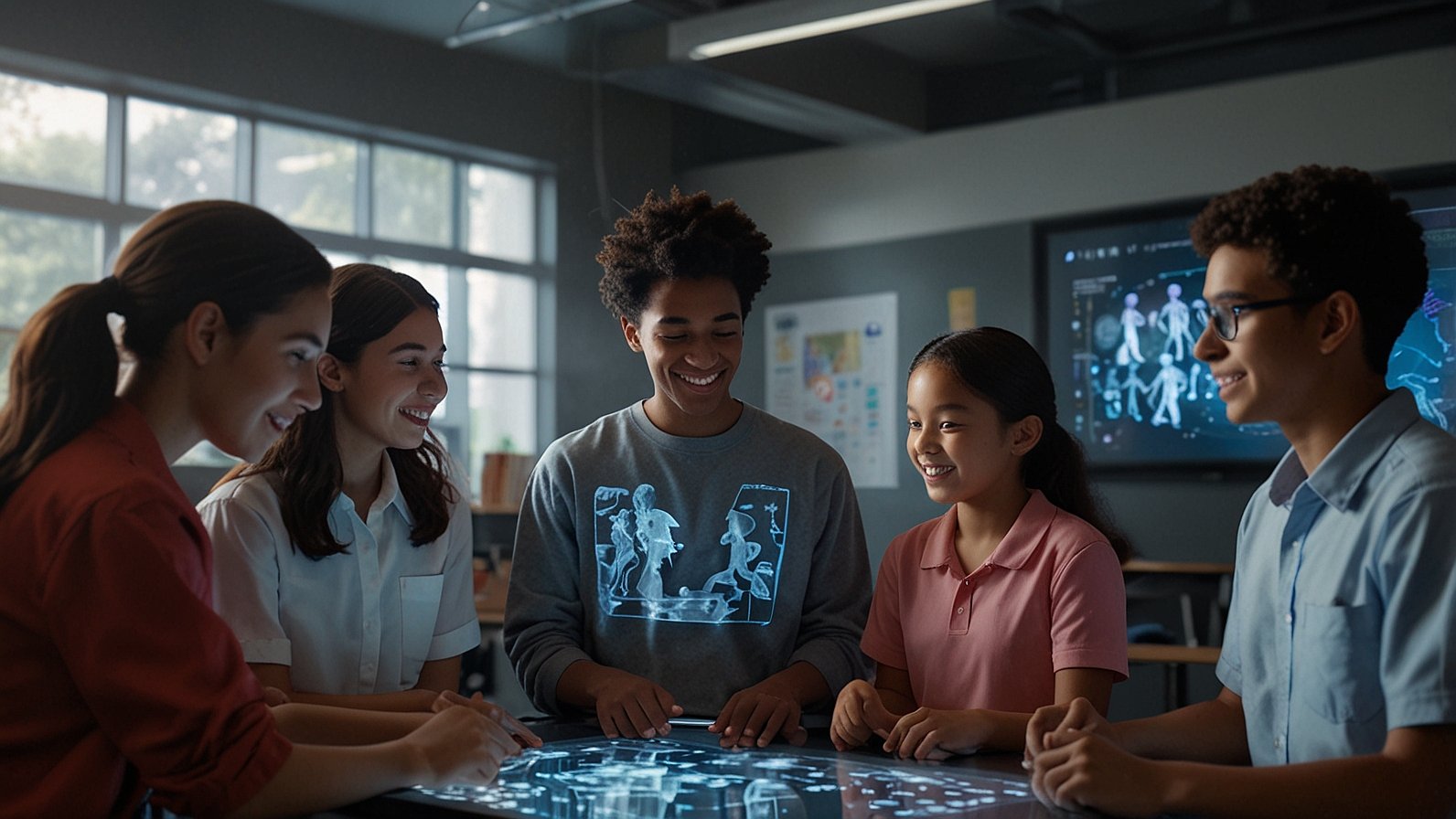Picture rows of desks facing a chalkboard. The teacher lectures. Students listen (or try to). Homework is uniform. Sound familiar? Now, imagine stepping into a vibrant space where holographic dinosaurs roam during history lessons, AI tutors adapt math problems instantly to your child’s level, and students in Tokyo collaborate on a climate project with peers in Toronto via seamless VR. Welcome to the potential reality of Classroom 20x – not just an upgrade, but a complete reimagining of learning designed to multiply engagement and outcomes exponentially. Could this be the key to unlocking every student’s true potential?
Why Our Classrooms Need a 20X Upgrade (And Fast!)
Let’s be honest: the traditional model hasn’t kept pace. Students are digital natives, yet many classrooms feel like relics. Engagement dips, one-size-fits-all teaching leaves many behind or unchallenged, and critical future skills like collaboration and problem-solving aren’t always nurtured deeply.
- The Engagement Gap: Studies consistently show passive learning leads to lower retention. We need active, involved learners.
- The Personalization Problem: Every child learns differently. Traditional models struggle to adapt in real-time.
- The Skills Mismatch: The workforce demands creativity, critical thinking, and tech fluency – skills needing dynamic practice environments.
Classroom 20x directly tackles these challenges. It’s not just adding a few tablets; it’s a systemic shift powered by smart integration of cutting-edge tech and pedagogy.
What Exactly IS Classroom 20x? Beyond the Buzzwords
So, what makes a Classroom 20x tick? Think of it as a dynamic, responsive learning ecosystem:
- AI-Powered Learning Journeys: Forget static textbooks. Sophisticated AI analyzes how each student learns – their pace, strengths, stumbling blocks. It then tailors the content, difficulty, and resources in real-time. Think of it like a GPS for learning, constantly recalculating the best route for each individual.
- Example: DreamBox Learning uses AI to adapt math problems, providing just the right hint or challenge, significantly boosting proficiency in districts like Baltimore County.
- Immersive AR/VR Worlds: History, science, and literature leap off the page (or screen). Students can explore ancient Rome, dissect a virtual frog with zero mess, or stand beside characters in a novel.
- Real Impact: Nottingham University uses VR to let medical students practice complex procedures risk-free, improving confidence and skill acquisition before touching a real patient.
- The “Smart” Classroom (IoT): Sensors monitor light, temperature, and noise for optimal focus. Interactive whiteboards become collaboration hubs. Student devices connect seamlessly, sharing work instantly. It’s the classroom’s own nervous system, constantly optimizing the environment.
- Cloud Collaboration Without Borders: Projects aren’t confined to four walls. Students use platforms like Google Workspace or Microsoft Teams to work together in real-time with peers across the globe, fostering cultural understanding and teamwork skills vital for the future. Imagine a project on water conservation shared between students in Arizona and Australia!
- Gamification That Actually Works: Learning becomes an engaging quest. Points, badges, leaderboards (used thoughtfully), and narrative-driven challenges make mastering complex concepts motivating and fun, turning “have to learn” into “want to learn.”
Traditional Classroom vs. Classroom 20x
| Feature | Traditional Classroom | Classroom 20x |
|---|---|---|
| Teacher Role | Lecturer, Information Source | Facilitator, Coach, Learning Guide |
| Learning Path | One pace, One path for all | Personalized, AI-driven, Adaptive Paths |
| Environment | Static, Physical Focus | Dynamic, Smart (IoT), Blended Physical/Digital |
| Resources | Textbooks, Limited Media | AR/VR, Interactive Simulations, Global Data |
| Collaboration | Primarily within classroom | Cloud-based, Global, Real-time Teams |
| Assessment | Periodic Tests, Quizzes | Continuous, Data-Driven Analytics, Skill Dashboards |
| Student Role | Passive Recipient | Active Participant, Co-Creator, Explorer |
| Primary Goal | Content Delivery | 20X Engagement & Outcomes, Future Skill Mastery |
Also Read: Classroom 15x: The Future of Student-Centered Learning Unveiled
The Teacher’s New Superpower: From Sage to Guide
One of the biggest shifts? The teacher’s role transforms dramatically. Out goes the “sage on the stage.” In comes the “guide on the side” – empowered like never before.
- Data Detective: Instead of guessing who’s struggling, teachers get real-time dashboards highlighting individual and class-wide needs. AI flags Johnny might need extra help with fractions before the test, while Sarah is ready for advanced algebra challenges.
- Learning Architect: Freed from constant whole-class lecturing, teachers design rich, project-based activities, facilitate deep discussions, and provide targeted small-group or one-on-one support.
- Mentor & Coach: Focus shifts to nurturing critical thinking, resilience, collaboration, and guiding students in applying knowledge – the skills that truly last.
- Tech Integrator: Teachers become skilled curators and facilitators of the technology, ensuring it enhances learning meaningfully, not just as a flashy add-on.
“The tech doesn’t replace me; it amplifies me,” says Ms. Rodriguez, a 7th-grade science teacher piloting Classroom 20x elements in Austin, Texas. “I finally have the time and insights to truly meet each student where they are and push them further.”
The Tangible Payoff: Why 20X Isn’t Just Marketing Hype
This isn’t just about cool gadgets. Classroom 20x aims for measurable, transformative results:
- Skyrocketing Engagement: When learning is personalized, interactive, and relevant, students are naturally more invested. Gamification and immersive experiences turn apathy into enthusiasm.
- Deeper Understanding & Retention: Active learning through simulations, projects, and tailored practice leads to mastery, not just memorization for a test.
- Mastering Future-Ready Skills: Collaboration across time zones? Solving problems in VR? Analyzing real-time data? This is the practical skill-building employers crave.
- Closing Achievement Gaps: Personalization means students who need support get it immediately, while advanced learners are constantly challenged. No one is left bored or hopelessly lost.
- Empowered Educators: Teachers gain powerful tools and insights, reducing burnout and reigniting their passion for teaching.
Early adopters are seeing promising results. Districts like Mooresville Graded School District (NC), focusing on 1:1 devices and data-driven instruction (core Classroom 20x principles), saw significant jumps in graduation rates and test scores, closing achievement gaps.
Facing the Realities: Challenges on the Road to 20X
Let’s not sugarcoat it. Implementing a true Classroom 20x isn’t plug-and-play. Key hurdles exist:
- Investment: The tech (hardware, software, infrastructure) requires significant upfront funding and ongoing maintenance budgets. It’s an investment, not just a cost.
- Teacher Training & Support: Teachers need robust, continuous professional development to harness these tools effectively and confidently. Throwing tech at them without training is a recipe for failure.
- Equity & Access: The digital divide is real. Ensuring all students have reliable devices and internet access, both at school and home, is non-negotiable for true equity.
- Data Privacy & Security: Safeguarding sensitive student data collected by AI and IoT devices is paramount. Clear policies and robust cybersecurity are essential.
- Pedagogy First: The biggest risk? Letting the tech drive the learning instead of the other way around. Classroom 20x must be built on solid educational principles, with technology as the powerful enabler.
The Future is Now: Getting Started with Classroom 20x
Feeling inspired but overwhelmed? You don’t need a magic wand or a bottomless budget to start moving towards Classroom 20x. Here’s how to begin:
- Start Small, Think Big: Pick one element! Maybe it’s implementing a powerful cloud collaboration tool school-wide, or piloting an AI-powered math program in one grade level. Get tangible experience and build momentum.
- Invest in Your Teachers: This is crucial. Dedicate resources to high-quality, ongoing PD focused on both the technology and the shifted pedagogical practices. Let teachers explore and experiment.
- Prioritize Robust Infrastructure: Ensure your network can handle the load. Reliable Wi-Fi and device management systems are the bedrock. Partner with IT early.
- Champion Equity: Audit your students’ access needs. Explore creative solutions like community Wi-Fi partnerships, device loaner programs, and offline-capable tools.
- Foster a Culture of Innovation: Encourage experimentation, celebrate learning (even from failures), and involve students and teachers in the design process. This is a journey, not a destination.
- Focus on Learning Outcomes: Always tie technology use back to clear educational goals. Ask: “How does this tool help our students learn better or develop crucial skills?”
Conclusion: Your Invitation to the Learning Revolution
Classroom 20x isn’t science fiction; it’s the evolving frontier of education. It represents a bold leap towards environments where technology dissolves barriers, personalization unlocks potential, and learning becomes a truly engaging, relevant, and empowering adventure for every student. Yes, the challenges are real, but the potential payoff – students who are not just educated, but inspired, skilled, and ready to thrive in a complex world – is worth the effort.
Ready to explore what 20X could mean for your students?
- What’s one small step you could take next week to make learning more personalized or interactive?
- How might you start a conversation about the future of learning in your school or community?
You May Also Read: Exploring UGA eLC and the Experiential Learning Community
FAQs
Is Classroom 20x just about expensive gadgets?
Absolutely not! While technology is a key enabler, the core is a shift in teaching philosophy (teacher as facilitator) and a focus on highly personalized, active, skills-based learning. The tech supports these goals, but thoughtful pedagogy comes first.
Won’t this just create more screen time? Isn’t that bad?
Classroom 20x emphasizes balanced and purposeful tech use. Screen time is integrated with hands-on projects, discussions, collaboration, and physical movement. AR/VR often involves kinesthetic interaction. The focus is on quality engagement, not passive consumption.
How can schools with tight budgets possibly afford this?
Start strategically! Focus on scalable solutions like cloud-based platforms or affordable AR apps via student devices. Seek grants, partnerships, and phased rollouts. Prioritize teacher training and robust Wi-Fi first – these foundations amplify the impact of any tech added later.
Doesn’t AI take away the human element of teaching?
On the contrary! AI handles time-consuming tasks like grading basic quizzes or identifying learning gaps, freeing teachers for the irreplaceable human elements: mentoring, inspiring, facilitating deep discussions, and providing personalized emotional and intellectual support. AI empowers teachers, not replaces them.
What about student data privacy with all this tech?
This is paramount. Schools must partner with vendors who prioritize privacy (look for compliance with FERPA, COPPA, GDPR), have transparent data policies, and offer strong security. Educating students on digital citizenship and responsible data sharing is also crucial.
Is there evidence that Classroom 20x actually improves learning?
Early adopters and research into core components (personalized learning, active methodologies, specific edtech tools) show promising results: increased engagement, deeper understanding, improved skill development, and better outcomes, especially when implemented thoughtfully with strong teacher support. Rigorous longitudinal studies are ongoing as the model evolves.
How do we prepare teachers for such a big change?
Comprehensive, ongoing professional development is essential. This includes not just technical training, but also coaching on new pedagogical approaches (facilitation, project design), data interpretation, and managing a dynamic, tech-rich classroom. Creating supportive communities for teachers to share experiences is key.











